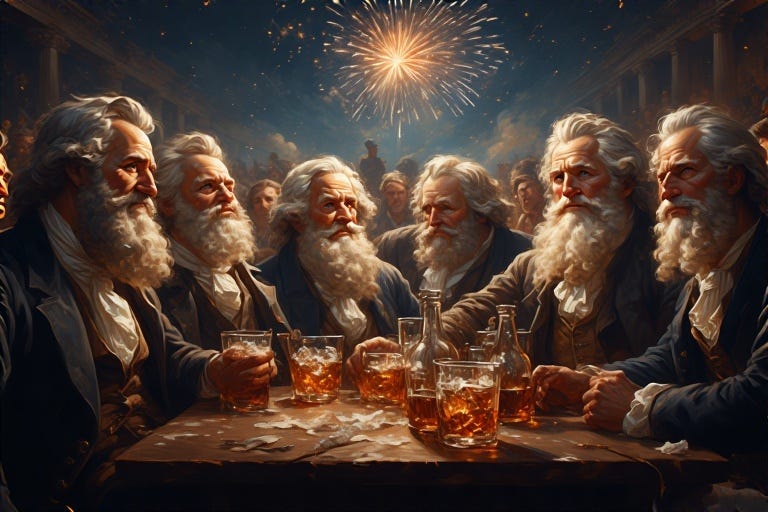Celebrate the 4th like our Founding Fathers Did...
Not just with fireworks either my fellow Americans, live up to the expectations of our founders with this wonderful drinking schedule handily generated by grok.ai. Now if we can work towards making alcohol as cheap as it was during the founders’ time…
Sample Drinking Schedule for an Upper-Class American Man, Colonial Era (circa 1750s–1770s)
This schedule outlines a typical day of alcohol consumption for a wealthy gentleman in colonial America, reflecting the era’s customs where alcohol was consumed regularly for refreshment, social bonding, and even perceived health benefits. Drinks varied by time of day, social context, and availability, with wealthier individuals favoring imported wines and spirits alongside local ciders and beers.
Morning
7:00 AM – Breakfast: A glass or two of hard cider or small beer (1–2% alcohol). These low-alcohol beverages were common breakfast drinks, considered safer than water due to concerns about water quality. Cider was particularly popular in regions like Virginia and Massachusetts.
Example: A pint of apple cider, possibly home-pressed from the estate’s orchard, served with bread, cheese, and cold meats.
Midday
12:00 PM – Midday Meal (Dinner): The main meal of the day, often accompanied by 1–2 glasses of Madeira wine or claret (red Bordeaux wine), both favored by the elite for their prestige and flavor. Rum punch, made with imported rum, sugar, citrus, and spices, might also be served, especially in warmer climates like the southern colonies.
Example: Two glasses of Madeira (fortified wine, ~18% alcohol) alongside a hearty meal of roasted meat, vegetables, and pies. Alternatively, a shared bowl of rum punch (~10–15% alcohol) passed among guests.
Note: Dinner was a social event, and drinking was moderate to maintain decorum, though quantities increased for larger gatherings.
Afternoon
3:00 PM – Social or Business Meeting: A tankard of small beer or a dram of rum during visits to a tavern, coffeehouse, or neighbor’s estate. Taverns were hubs for upper-class men to discuss politics or business, and a single drink was typical during brief meetings.
Example: A half-pint of small beer (~1–2% alcohol) or a small glass of neat rum (~40% alcohol) while reviewing trade contracts or debating colonial policies.
Evening
6:00 PM – Supper: A lighter meal with 1–2 glasses of wine, often Madeira or port, or a tankard of cider. Upper-class men might linger over drinks if entertaining guests, with toasts to health or the king (pre-Revolution).
Example: A glass of port (~20% alcohol) with fruit, nuts, and cheese, or a pint of cider if dining informally.
8:00 PM – Evening Leisure: After supper, gentlemen often retired to a parlor or study for conversation, cards, or reading. This was the time for stronger spirits or fortified wines, consumed in moderation to reflect refinement.
Example: A glass of brandy (~40% alcohol) or Madeira, sipped slowly while smoking a pipe or playing whist. In wealthier households, a punch bowl might be prepared for group enjoyment.
Night
10:00 PM – Before Bed: A small glass of rum or a toddy (hot rum mixed with water, sugar, and spices) as a nightcap, believed to aid digestion and promote sleep.
Example: A 2-ounce serving of rum toddy (~20% alcohol after dilution) served warm.
Notes
Total Daily Consumption: Approximately 2–4 pints of low-alcohol beverages (cider, small beer) and 3–5 glasses of stronger wines or spirits (Madeira, port, rum, brandy), equivalent to 4–8 standard drinks by modern measures. This was typical for the era, as alcohol was a dietary staple.
Social Context: Upper-class men drank to demonstrate wealth (e.g., imported Madeira over local cider) and hospitality. Excessive drunkenness was frowned upon, as gentility required moderation.
Regional Variations: In New England, cider and rum dominated; in the South, Madeira and rum punch were preferred; in urban centers like Philadelphia, claret and port were common among the elite.
Health Beliefs: Alcohol was thought to be medicinal, with small beer and cider seen as safer than water, and spirits like rum or brandy used to “settle the stomach” or “warm the blood.”
This schedule is illustrative, based on historical accounts of colonial drinking habits, such as those described in diaries of Virginia planters or Philadelphia merchants. Actual consumption varied by individual, region, and occasion.




